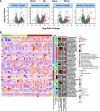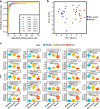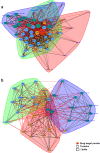Multi-platform omics analysis reveals molecular signature for COVID-19 pathogenesis, prognosis and drug target discovery
- PMID: 33859163
- PMCID: PMC8047575
- DOI: 10.1038/s41392-021-00508-4
Multi-platform omics analysis reveals molecular signature for COVID-19 pathogenesis, prognosis and drug target discovery
Abstract
Disease progression prediction and therapeutic drug target discovery for Coronavirus disease 2019 (COVID-19) are particularly important, as there is still no effective strategy for severe COVID-19 patient treatment. Herein, we performed multi-platform omics analysis of serial plasma and urine samples collected from patients during the course of COVID-19. Integrative analyses of these omics data revealed several potential therapeutic targets, such as ANXA1 and CLEC3B. Molecular changes in plasma indicated dysregulation of macrophage and suppression of T cell functions in severe patients compared to those in non-severe patients. Further, we chose 25 important molecular signatures as potential biomarkers for the prediction of disease severity. The prediction power was validated using corresponding urine samples and plasma samples from new COVID-19 patient cohort, with AUC reached to 0.904 and 0.988, respectively. In conclusion, our omics data proposed not only potential therapeutic targets, but also biomarkers for understanding the pathogenesis of severe COVID-19.
Conflict of interest statement
The authors declare no competing interests.
Figures






References
-
- W.H.O. Coronavirus disease (COVID-19) dashboard. https://covid19.who.int/ (2020).
Publication types
MeSH terms
Substances
LinkOut - more resources
Full Text Sources
Other Literature Sources
Medical
Research Materials
Miscellaneous

